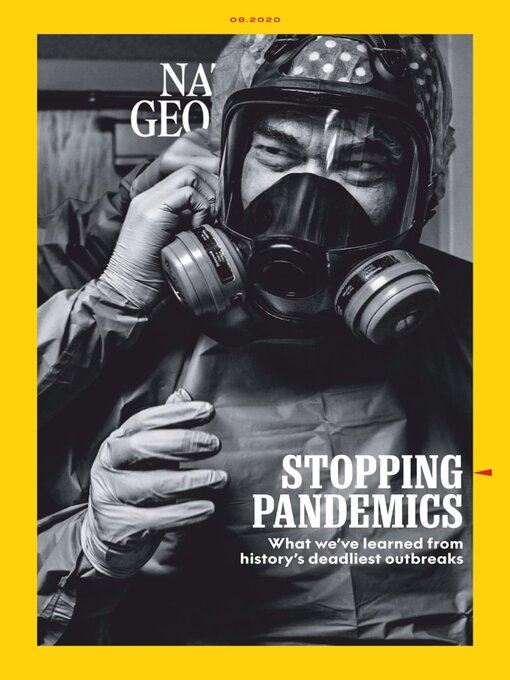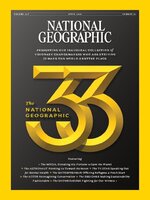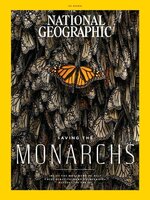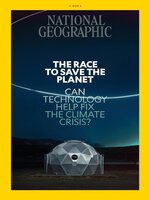Amazing discoveries and experiences await you in every issue of National Geographic magazine. The latest news in science, exploration, and culture will open your eyes to the world’s many wonders.
What We Don’t Learn From History
METROPOLIS ON LOCKDOWN
THE BACKSTORY • NEW YORK HAS SEEN CRISES BEFORE—BUT FIGHTING THE COVID-19 PANDEMIC BROUGHT IT NEARLY TO A STANDSTILL
When Virtual Life Turns Into Quarantine • MY GENERATION THRIVES IN THE VIRTUAL WORLD. BUT WHEN COVID-19 CUT US OFF FROM THE PHYSICAL WORLD, SOMETHING WAS LOST.
Had COVID-19 not canceled
THE DODO’S NEW LOOK
TO ATTRACT THE LADIES, A MALE MOTH FLASHES THIS
DISPATCHES FROM THE FRONT LINES OF SCIENCE AND INNOVATION
HOW CAN INSECTS TURN COLORS THEY CAN’T SEE? • RESEARCH ON THESE CHAMELEON-LIKE LARVAE SHOWS THEY ‘SEE’ WITH MORE THAN THEIR EYES.
Cement of the future?
IN BLACK AND WHITE, SLOWLY
OSCAR NILSSON
MAKING PORCUPINE BABIES TAKES ALL MANNER OF MOVES
The Climb of His Life • WHEN THE WORLD’S DEEPEST KNOWN CAVE SUDDENLY FILLS WITH WATER, A PHOTOGRAPHER TRAVELING WITH ELITE RUSSIAN EXPLORERS MUST SCRAMBLE TO SURVIVE.
How pandemics change us • Will we remember the lessons we have learned after the danger has passed?
Finding a remedy • At a lecture in Boston early in 1721, Cotton Mather, the hellfire Puritan minister, announced the coming of ‘the destroying angel,’ a terrifying disease bearing down on the city. England was already under siege.
An Empire Subdues a Pandemic • Colonizers from Europe brought Old World diseases with them to the Americas, devastating indigenous populations. Almost 300 years later, the Spanish king ordered an ambitious mission to fight one of the deadliest: smallpox.
Plague • The third pandemic of the plague began in China in 1855 and reached every continent but Antarctica between 1894 and 1900. The bacteria hit Madagascar in 1898 and remains today.
Scale of Suffering • Disease has spelled suffering, death, and even the demise of entire civilizations. Some pathogens did their damage swiftly, others moved in deadly waves over decades. Here are some of the worst outbreaks of all time—those that changed the course of history.
Cholera changes cities • People were willing to accept the next great lesson in ending pandemics only because of a disease that was among the most frightening they had ever experienced. When this scourge broke out in 1817 in the city of Jessore, now part of Bangladesh, its new virulence shocked people even there, though they knew its terrors from past outbreaks.
FILTH THEORY • Appalled by conditions he observed in an army hospital, a British doctor recognized the importance of good hygiene and instituted reforms that have saved countless lives on and off the battlefield
Polio • A highly infectious virus that mainly affects children, polio has been eradicated in much of the world thanks to a global vaccination campaign. But the disease remains in a few pockets of Asia and Africa.
Germ theory changes everything • For 200 years, a gathering chorus of voices raised tentative versions of the idea that ‘animalcules,’ or germs, cause disease. Proponents of humoral medicine, and of filth theory, succeeded for a time in shouting them down.
WONDER DRUG • With the world engulfed in war, the drive to develop drugs against infection in the wounded took on new urgency, leading to the successful mass production of penicillin, the first effective antibiotic.
Ebola • Since 1976, when it first emerged in Sudan and near the Ebola River in what is now the Democratic Republic of the Congo, the Ebola virus has reappeared periodically in central and western Africa.
WATER EVERYWHERE AND NOWHERE • A 2,400-MILE TREK ACROSS...

 Oct 01 2025
Oct 01 2025
 Sep 01 2025
Sep 01 2025
 Aug 01 2025
Aug 01 2025
 Jul 01 2025
Jul 01 2025
 Jun 01 2025
Jun 01 2025
 May 01 2025
May 01 2025
 Apr 01 2025
Apr 01 2025
 Mar 01 2025
Mar 01 2025
 Feb 01 2025
Feb 01 2025
 Jan 01 2025
Jan 01 2025
 Dec 01 2024
Dec 01 2024
 Nov 01 2024
Nov 01 2024
 Oct 01 2024
Oct 01 2024
 Sep 01 2024
Sep 01 2024
 Aug 01 2024
Aug 01 2024
 Jul 01 2024
Jul 01 2024
 Jun 01 2024
Jun 01 2024
 May 01 2024
May 01 2024
 Apr 01 2024
Apr 01 2024
 Mar 01 2024
Mar 01 2024
 Feb 01 2024
Feb 01 2024
 Jan 01 2024
Jan 01 2024
 Dec 01 2023
Dec 01 2023
 Nov 01 2023
Nov 01 2023